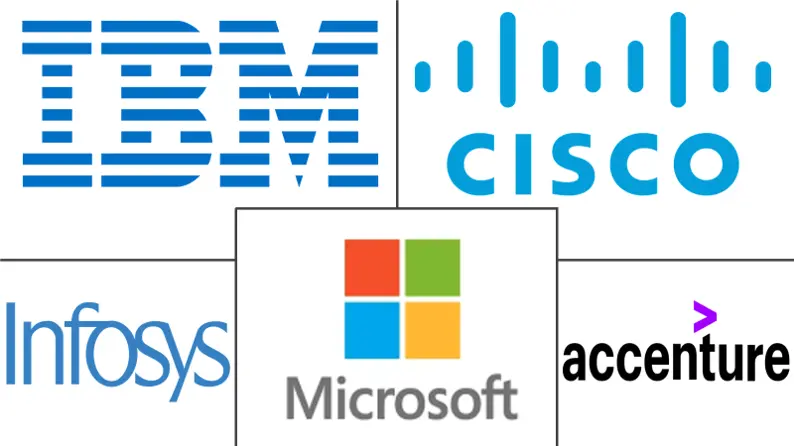Internet Of Things In Banking Market Size and Share
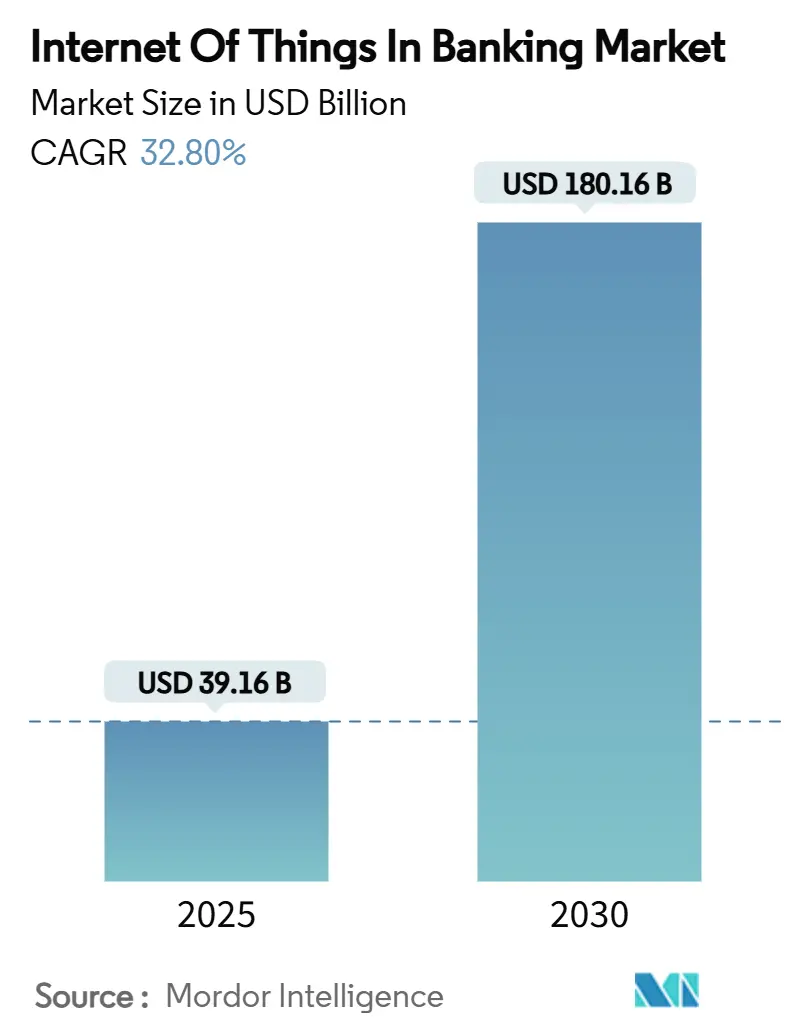
Internet Of Things In Banking Market Analysis by Mordor Intelligence
The Internet of Things in Banking market stands at USD 39.16 billion in 2025 and is forecast to reach USD 180.61 billion by 2030, advancing at a 32.8% CAGR. The growth pace mirrors banks’ shift toward sensor-rich operating models, real-time data flows, and embedded payments that link financial services to daily device usage. Institutions are layering connected sensors on ATMs, branches, and mobile endpoints to streamline cash operations, trigger context-aware offers, and automate payments initiated from vehicles and smart appliances. Regulatory push, notably the Consumer Financial Protection Bureau’s open-banking rule effective April 2026, is accelerating API readiness that lets third-party developers fuse IoT signals with banking data. Parallel mandates in Europe under PSD3 and the proposed Payment Services Regulation expand strong-authentication requirements and create secure rails for IoT-enabled transactions.[1]Payments Practice, “PSD3 and PSR: what to expect,” ACI Worldwide, aciworldwide.com Banks that orchestrate these capabilities report 30-40% efficiency gains and 20-30% uplifts in product-recommendation hit rates when omnichannel IoT programs mature.[2]Editorial staff, “Omnichannel efficiency with IoT,” World Wide Technology, wwt.comSupply-chain constraints around semiconductors and uneven 5G rollout still temper device deployments, yet falling sensor costs and edge-compute advances point to sustained expansion of the Internet of Things in the Banking market through the decade.
Key Report Takeaways
- By component, services commanded 58% of 2024 revenue, while solutions posted the fastest 33.37% CAGR outlook through 2030.
- By application, security led with 36.2% of the Internet of Things in the Banking market share in 2024 and is projected to grow at 34.73% CAGR to 2030.
- By organization size, large enterprises held a 64.1% share in 2024, whereas SMEs are set to expand at a 33.71% CAGR during the same period.
- By end user, retail banking captured 42.7% revenue in 2024; insurance is the fastest-growing segment at 34.12% CAGR through 2030.
- By geography, North America retained 38.5% of 2024 revenue, but Asia-Pacific is forecast to advance at 33.86% CAGR to 2030.
Global Internet Of Things In Banking Market Trends and Insights
Drivers Impact Analysis
| Driver | (~) % Impact on CAGR Forecast | Geographic Relevance | Impact Timeline |
|---|---|---|---|
| Omnichannel customer-experience push | +5.2% | Global; strongest in North America and EU | Medium term (2-4 years) |
| Real-time fraud detection and security | +6.8% | Global; critical in emerging APAC markets | Short term (≤ 2 years) |
| Regulatory open-banking mandates | +4.1% | North America and EU first; extending to APAC | Medium term (2-4 years) |
| Branch/ATM cost-optimization via sensors | +3.9% | Mature banking markets worldwide | Long term (≥ 4 years) |
| IoT-enabled embedded payments (cars and appliances) | +7.3% | North America and EU early; rapid APAC scaling | Long term (≥ 4 years) |
| Edge-analytics hyper-personalized microlending | +4.7% | APAC core; spill-over to Latin America and Africa | Medium term (2-4 years) |
| Source: Mordor Intelligence | |||
Omnichannel Customer-Experience Push
Banks wire sensors into ATMs, mobile apps, and wearables to create journeys that pivot seamlessly across physical and digital environments. NatWest upgraded 5,500 ATMs with 19-inch touchscreens and live telemetry that flags downtime before it occurs. The bank also released a retail-banking app for Apple Vision Pro so clients can move funds using gaze and gesture. Such integrations let institutions blend geolocation, device health, and purchase patterns to anticipate needs, lifting cross-sell accuracy by one-third on mature rollouts. Sensor analytics enable pre-visit branch staffing, queue alerts, and dynamic personalized offers that raise customer satisfaction scores by double digits. The Internet of Things in Banking market, therefore, benefits from higher user stickiness and reduced operating costs.
Real-Time Fraud Detection and Security
Distributed sensors feed anomaly engines that flag suspicious patterns in milliseconds. A federated-learning model combining device telemetry with transaction streams now achieves 96.3% fraud-detection accuracy while keeping data local for privacy. Smart cameras and environmental sensors guard ATMs and cash machines, detecting skimming devices or abnormal temperature spikes that hint at tampering. Blockchain hashes applied at the edge create immutable logs for dispute resolution, and on-device AI reduces false positives that once annoyed customers. Early adopters report fraud-loss reductions of more than 20% in the first implementation year. Security urgency propels continual investment, fortifying the Internet of Things in the Banking market against cybercrime-related hesitancy.
Regulatory Open-Banking Mandates
The CFPB requires banks above USD 850 million in assets to provide standardized, permissioned access to customer data by April 2026. This mandate creates rails on which IoT manufacturers can embed payments, such as vehicles paying for charging or fridges reordering groceries. Europe’s PSD3 draft rules likewise oblige dedicated interfaces and strong customer authentication. Banks see compliance not as overhead but as a springboard to new fee streams through licensed IoT ecosystems. Standard APIs trim integration timelines by half, boosting ROI for pilot projects and sustaining growth in the Internet of Things in Banking market.
IoT-Enabled Embedded Payments (Cars and Appliances)
Visa and BMW have piloted connected-car wallets that settle fuel, tolls, and maintenance without driver input.[3]Editorial staff, “Connected car payments,” Cognizant, cognizant.com Smart homes now reorder detergent as soon as sensors record low levels, with payments cleared on background rails. Machine-to-machine transactions scale via 5G slices that guarantee latency below 10 milliseconds, supporting 75 billion devices forecast to be online in 2025. Usage-based insurance leverages telemetry to adjust premiums daily, and pay-per-use loans for appliances align repayments with actual utilization. These models reinforce customer loyalty and diversify revenue, lifting the Internet of Things in Banking market trajectory.
Restraints Impact Analysis
| Restraint | (~) % Impact on CAGR Forecast | Geographic Relevance | Impact Timeline |
|---|---|---|---|
| Data-privacy and cybersecurity concerns | –4.3% | Global; stricter enforcement in EU and California | Short term (≤ 2 years) |
| Device/platform interoperability gaps | –3.1% | Global; pronounced in fragmented APAC markets | Medium term (2-4 years) |
| Rural 5G latency bottlenecks | –2.8% | Rural areas worldwide; acute in developing markets | Long term (≥ 4 years) |
| ESG scrutiny on IoT energy consumption | –1.9% | EU and North America first; spreading globally | Medium term (2-4 years) |
| Source: Mordor Intelligence | |||
Data-Privacy and Cybersecurity Concerns
The EU Cyber Resilience Act obliges manufacturers to ship devices with automatic security updates, exposing vendors that cannot maintain over-the-air patching. Banks must track diverging rules from California’s Consumer Privacy Act to India’s Digital Personal Data Protection law, adding compliance overhead. Breaches at a single sensor can undermine banking cores if segmentation is weak. Federated-learning pilots show 99.94% model accuracy without exporting raw data, but most lenders still face skills gaps in securing device fleets.[4]Y. Zhou et al., “Privacy-preserving IoT models for banking,” MDPI Sensors, mdpi.com Rising insurance premiums for cyber coverage inflate project costs and can slow adoption within the Internet of Things in Banking market.
Device / Platform Interoperability Gaps
IoT uses dozens of protocols, from MQTT to Zigbee, that rarely interoperate natively. Nacha’s Afinis group is building common APIs for payment endpoints, yet many devices rely on proprietary formats. Banks wanting a pan-vendor network often insert middleware that adds latency and cost. Integration delays have reached nine months on multi-vendor pilots, prompting some institutions to restrict scope to single-supplier ecosystems. In emerging Asia, local manufacturers’ custom stacks deepen fragmentation, limiting the addressable slice of the Internet of Things in the Banking market until standardization crystallizes.
Segment Analysis
By Component: Services Drive Implementation Success
Services hold 58% of 2024 revenue, underscoring that domain expertise, regulatory insight, and 24-hour support tilt outcomes in complex rollouts. The Internet of Things in Banking market size for services is projected to expand at 33.37% CAGR, reflecting demand for integrators who stitch sensors into legacy cores and cloud fabrics. Banks often outsource threat modeling, compliance mapping, and device-life-cycle governance to reduce risk. Solutions cover hardware kits, software platforms, and connectivity bundles, and they benefit from cloud-native shifts that let lenders retire on-premises data centers. Joint offers, such as IBM-Wipro’s AI-enabled platform, bundle analytics and cyber hardening, amplifying competition among solution providers.
Second-generation deployments favor pay-as-you-grow managed services, pushing smaller banks to embrace turnkey bundles rather than capex-heavy in-house builds. Vendors are packaging edge-compute nodes with pre-certified connectors for open-banking APIs, trimming time to value. Hardware margins remain thin, so suppliers pivot to annuity models around device monitoring and predictive maintenance. As cloud vendors release financial-grade edge stacks, the Internet of Things in Banking market further tilts toward service-centric economics.
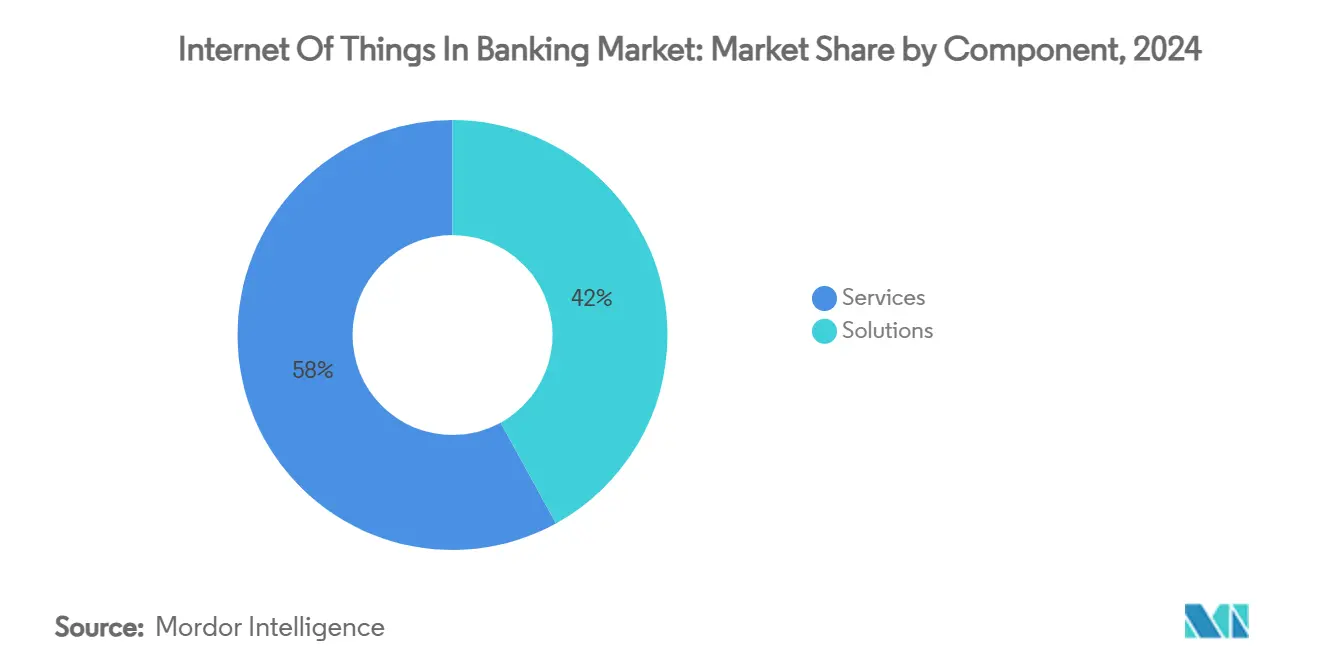
Note: Segment shares of all individual segments available upon report purchase
By Application: Security Leads Amid Rising Threats
Security applications captured 36.2% of 2024 revenue and expand at 34.73% CAGR, riding regulatory imperatives and growing attack vectors. The Internet of Things in Banking market size for security reached USD 14.17 billion in 2025 and is forecast to exceed USD 71 billion by 2030. Smart ATMs detect temperature anomalies, shock events, or tampering patterns and can lock dispensers automatically. Device-level encryption and root-of-trust chips now ship by default in premium terminals, reducing compliance audit time.
Monitoring, data management, and customer experience modules share infrastructure but vary in analytics heft. Banks leverage telemetry to optimize branch energy use, cutting power costs by up to 12% year over year. Customer-experience engines marry foot-traffic sensors with CRM histories to trigger in-branch personalized greetings. Integrated platforms that host multiple applications on the same sensor grid help reduce overall TCO, broadening appeal across the Internet of Things in the Banking market.
By Organization Size: SMEs Accelerate Adoption
Large institutions own 64.1% of current spending thanks to resources for multi-year programs, yet SMEs post the liveliest 33.71% CAGR. Subscription-based edge gateways and serverless analytic stacks let community banks bypass heavy lift. The Internet of Things in Banking market share held by SMEs is expected to breach 40% by 2030 as turnkey offerings close capability gaps. Smaller lenders prioritize branch automation and real-time alerts for cash-handling compliance, yielding tangible ROI within months.
Global tier-ones are experimenting with quantum-safe encryption and AI copilots that parse sensor data to advise frontline staff. They also pilot micro-branch formats featuring video kiosks and robot cash recyclers to cut real-estate costs. These innovations seed best practices that filter down to mid-tier banks once costs rationalize, nurturing inclusive growth across the Internet of Things in the Banking industry.
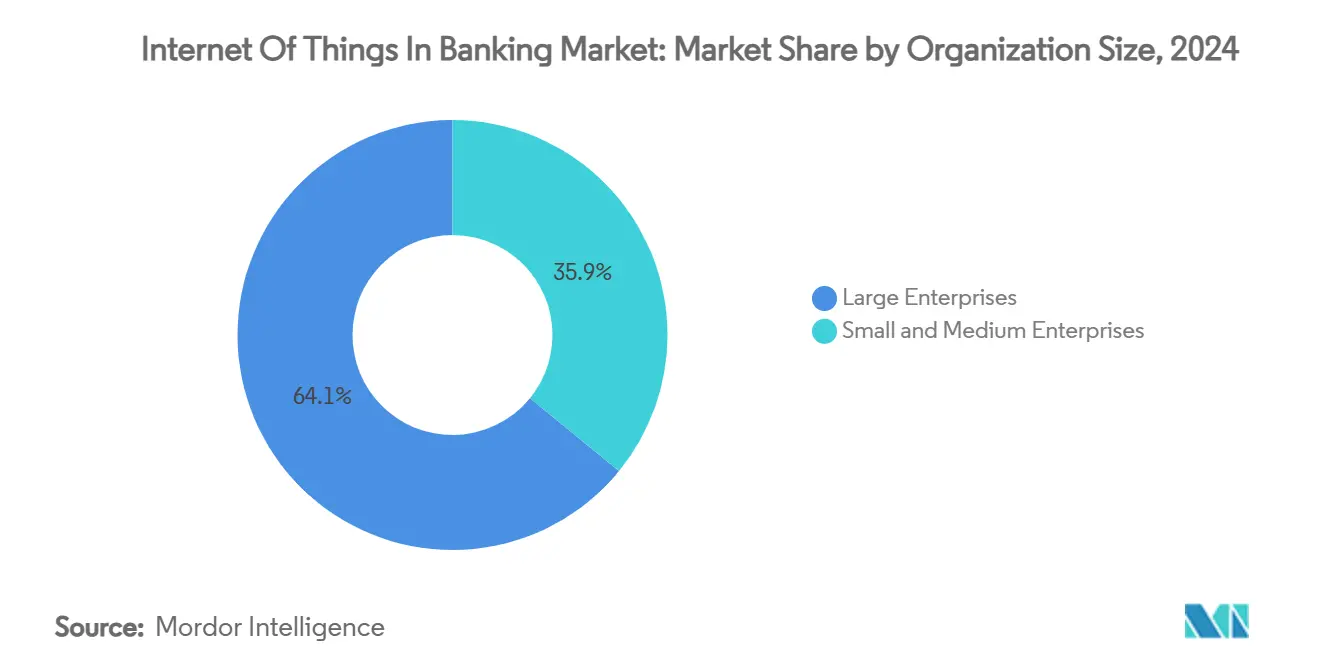
By End User: Insurance Emerges as Growth Leader
Retail banking continues to dominate with 42.7% of 2024 revenue, powered by consumer-facing ATMs, mobile wallets, and smart-home finance links. Yet insurance logs the quickest 34.12% CAGR as underwriters mine telemetry from cars, homes, and wearables to craft usage-based policies. The Internet of Things in Banking market size for insurance applications is projected to rise from USD 6.2 billion in 2025 to USD 29.8 billion in 2030. Corporate banking leans on IoT in trade-finance corridors where sensors verify shipment integrity and trigger automatic bill-of-lading payments.
Investment banks test smart-trading floors whose occupancy sensors regulate HVAC and lighting, paring energy bills while feeding ESG dashboards. Non-banking finance firms integrate IoT into peer-to-peer lending models, validating collateral conditions in real time. Cross-industry convergence blurs classical boundaries, underpinning diversified revenue streams within the Internet of Things in the Banking market.
Geography Analysis
North America retains leadership with 38.5% of 2024 revenue, buoyed by solid cyber legislation and early fintech-bank partnerships. Sensor-enabled branches post 30-40% productivity uplifts, and quantum-trial algorithms run 1,000 times faster than legacy optimizers. Canada advances cash-circle inclusion through connected community ATMs, while Mexico leverages IoT-based remittance kiosks that cut transaction fees. The Internet of Things in Banking market sees federal support for 5G expansion into underserved zones, flattening latency disparities across the continent.
Asia-Pacific is the growth engine, charging ahead at 33.86% CAGR. China’s AIBank serves more than 100 million customers on microservices cores that ingest IoT data to personalize lending. India deploys edge mini-data centers to extend mobile banking into rural districts where fiber remains sparse. Southeast Asian super-apps fuse ride-hailing, food delivery, and instant credit, with IoT sensors tracking driver performance for dynamic insurance pricing. Regional regulators fast-track sandbox approvals, ensuring the Internet of Things in Banking market captures rising smartphone penetration.
Europe predicates progress on privacy and ESG. PSD3 and the pending PSR impose mandatory authentication and harmonized APIs, fostering secure device onboarding. Institutions integrate energy-monitoring sensors to gauge carbon footprints, aligning with commitments to net-zero roadmaps. Device makers embed power-thrifty chips, addressing scrutiny over IoT electricity draw. In emerging regions of Latin America and the Middle East and Africa, payments modernization programs and mobile-money regimes create fertile ground for leapfrogging deployments. For instance, Brazil’s PIX and Nigeria’s eNaira rails allow IoT endpoints to initiate real-time payments, diversifying revenue sources within the Internet of Things in Banking market.
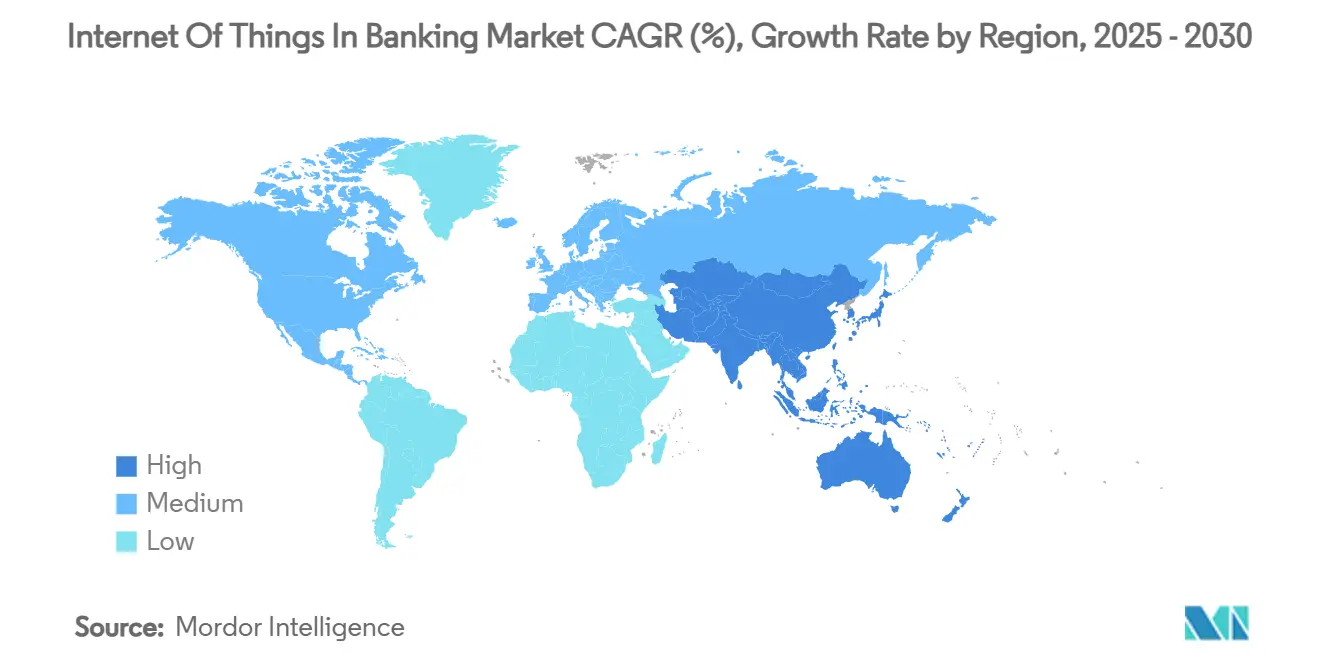
Competitive Landscape
The Internet of Things in Banking market is moderately fragmented, with cloud hyperscalers, financial-software incumbents, device makers, and pure-play IoT platforms contesting influence. IBM, Microsoft, and Oracle leverage expansive cloud zones and regulatory accreditations to win multi-country deals. Specialized suppliers such as NCR Atleos focus on smart-ATM fleets, while Diebold Nixdorf concentrates on cash recyclers equipped with predictive-maintenance AI. Partnerships trump zero-sum rivalry: IBM pairs with Wipro to blend systems integration and AI accelerators, and Temenos links SaaS core banking with Taurus to safeguard digital assets.
Patent-tracking services show spikes in filings around biometric gating, proximity payments, and distributed edge orchestration. Vendors collaborate with telcos to guarantee 5G quality-of-service slices for latency-critical financial events. White-space opportunities persist in agricultural lending, where IoT crop sensors inform weather-indexed payouts, and in cross-border SME corridors lacking resilient device coverage. Vendor differentiation hinges on compliance toolkits and pre-certified API stacks that hasten time to revenue for banks entering the Internet of Things in the Banking industry.
Pricing models tilt toward outcome-based fees tied to fraud-loss reduction or service-availability metrics. As device volumes climb, suppliers bundle lifecycle management with carbon-tracking dashboards to answer ESG audits. Alliance ecosystems encompassing chipset designers, security-certificate authorities, and managed-connectivity operators underpin holistic offerings. Customer surveys indicate that banks favor vendors able to furnish multiyear roadmaps with clear regulatory audit support, shaping procurement cycles across the Internet of Things in Banking market.
Internet Of Things In Banking Industry Leaders
-
IBM Corporation
-
Infosys Limited
-
Accenture PLC
-
Cisco Systems, Inc.
-
Microsoft Corporation
- *Disclaimer: Major Players sorted in no particular order
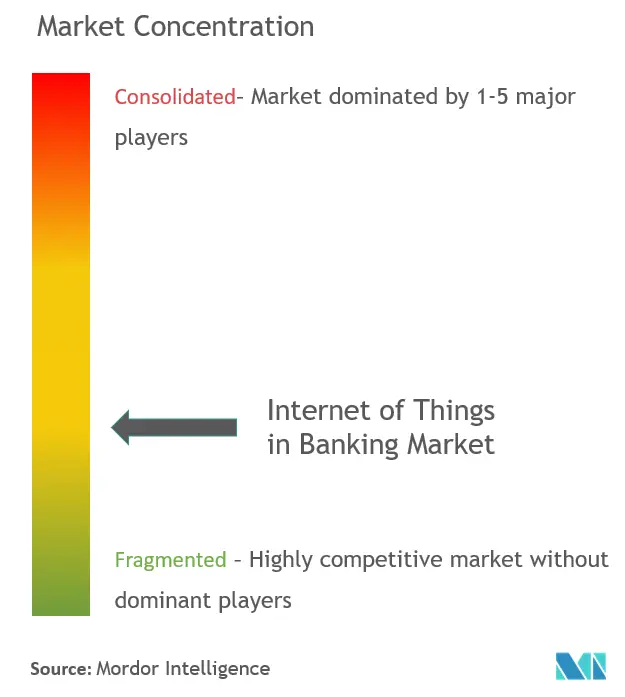


Recent Industry Developments
- June 2025: KAF Digital Bank launched on the Temenos SaaS platform, deploying Microsoft Azure to embed IoT-ready Islamic banking services in Malaysia.
- May 2025: Oracle earmarked USD 40 billion for Nvidia chips in the Stargate data-center project, boosting AI and IoT computing capacity for financial workloads.
- March 2025: NCR Atleos posted USD 4.3 billion 2024 revenue and highlighted sensor-rich ATM upgrades that elevate self-service uptime.
- February 2025: Temenos integrated with Taurus to let banks manage digital assets atop IoT telemetry while staying compliant.
Global Internet Of Things In Banking Market Report Scope
The Internet of things in the banking market shows fast mobilization and digitization in the banking and financial services business. Businesses are leveraging the opportunity of IoT in finance to leverage data and minimize the risks that are endemic to this sector. The main points of focus for innovation for organizations working in retail banking will be faster payments, improved operational efficiency (to support the move to open banking), and other responsive mobile services.
The Internet of Things in the Banking Market is segmented by Type (Solution and Services), Application (Security, Monitoring, Data Management, Customer Experience Management), and Geography.
The market sizes and forecasts are provided in terms of value (USD million) for all the above segments.
| Solutions |
| Services |
| Security |
| Monitoring |
| Data Management |
| Customer Experience Management |
| Other Applications |
| Large Enterprises |
| Small and Medium Enterprises |
| Retail Banking |
| Corporate Banking |
| Investment Banking |
| Non-Banking Financial Companies |
| Insurance |
| North America | United States | |
| Canada | ||
| Mexico | ||
| South America | Brazil | |
| Argentina | ||
| Rest of South America | ||
| Europe | Germany | |
| United Kingdom | ||
| France | ||
| Russia | ||
| Rest of Europe | ||
| Asia Pacific | China | |
| India | ||
| Japan | ||
| South Korea | ||
| ASEAN | ||
| Rest of Asia Pacific | ||
| Middle East and Africa | Middle East | Saudi Arabia |
| United Arab Emirates | ||
| Turkey | ||
| Rest of Middle East | ||
| Africa | South Africa | |
| Nigeria | ||
| Rest of Africa | ||
| By Component | Solutions | ||
| Services | |||
| By Application | Security | ||
| Monitoring | |||
| Data Management | |||
| Customer Experience Management | |||
| Other Applications | |||
| By Organization Size | Large Enterprises | ||
| Small and Medium Enterprises | |||
| By End User | Retail Banking | ||
| Corporate Banking | |||
| Investment Banking | |||
| Non-Banking Financial Companies | |||
| Insurance | |||
| By Geography | North America | United States | |
| Canada | |||
| Mexico | |||
| South America | Brazil | ||
| Argentina | |||
| Rest of South America | |||
| Europe | Germany | ||
| United Kingdom | |||
| France | |||
| Russia | |||
| Rest of Europe | |||
| Asia Pacific | China | ||
| India | |||
| Japan | |||
| South Korea | |||
| ASEAN | |||
| Rest of Asia Pacific | |||
| Middle East and Africa | Middle East | Saudi Arabia | |
| United Arab Emirates | |||
| Turkey | |||
| Rest of Middle East | |||
| Africa | South Africa | ||
| Nigeria | |||
| Rest of Africa | |||


Key Questions Answered in the Report
What is the growth outlook for the Internet of Things in Banking market between 2025 and 2030?
The market is projected to rise from USD 39.16 billion in 2025 to USD 180.61 billion by 2030 at a 32.8% CAGR.
Which component segment holds the largest share today?
Services lead with 58% of 2024 revenue because banks rely on external expertise for integration, security, and compliance.
Why are security applications expanding fastest?
Rising cyber threats and strict regulations push banks to embed tamper detection, biometric access, and encrypted communications, fueling a 34.73% CAGR for security solutions.
How does open banking regulation influence IoT adoption?
Mandated APIs allow approved third parties to access banking data, enabling connected cars, appliances, and wearables to initiate secure payments automatically.
Which region delivers the strongest growth momentum?
Asia-Pacific posts a 33.86% CAGR as digital-only banks in China and India scale IoT-centric services across mobile-first populations.
What key challenge hampers large-scale IoT rollouts in banking?
Platform interoperability gaps force banks to juggle multiple protocols, extending project timelines and raising integration costs.
Page last updated on:
